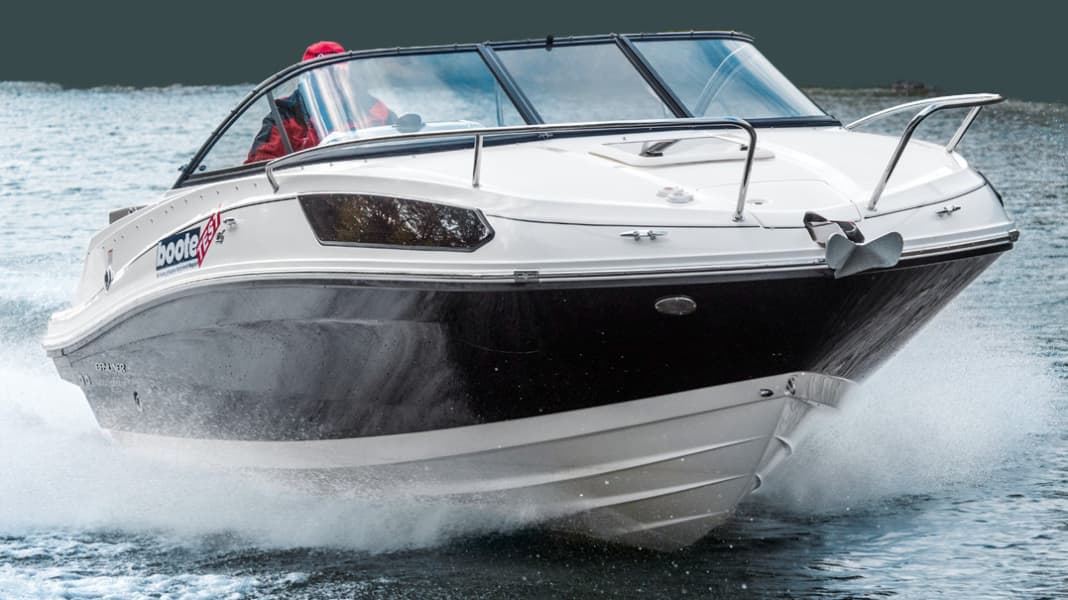
Anyone who thinks I've only just seen this boat in BOOTE is not entirely wrong. At the beginning of last year, we published the test of its sister with an inboard motor. It is only logical that we are now testing the outboard version quite soon, as powerful outboards are becoming increasingly fashionable and many American manufacturers are developing their new boats exclusively for outboard mounting.
In addition, there are no longer any petrol inboard alternatives in the power range below 200 hp, especially for boats between 17 and 20 feet. Our test candidate in BOOTE 3/18 was equipped with exactly this 200 hp. A V6 petrol engine from MerCruiser brought the VR5 up to speed.
Our current test boat, on the other hand, comes with a 150 hp outboard motor, also from Mercury. If you compare the measured values of the two test candidates, the following differences are immediately apparent: in terms of top speed, the inboard version has the edge at around 1.5 knots.
When travelling economically, the outboard model is almost 2 kn faster and, above all, consumes only 0.90 l/sm and not 1.11 l/sm like the inboard boat. This results in a range increase of over 20 nm based on the tank capacity of 132 litres minus 15% reserve. At full throttle, the difference is around 5 nm and at displacement speed (around 5 kn) just under 10 nm. What about the noise level?
Here, too, the measured values of the outboard motor are always below those of its encapsulated colleague. At full throttle, for example, this is 6 dB/A and in the displacement range even up to 8 dB/A more. So if you can do without a little more top speed, you are better off with the outboard model purely in terms of the measured values.
Subjective driving impressions: When manoeuvring, the test boat can be driven precisely with typical turning circles of between around 1 and 2 boat lengths and a slightly delayed (around 4 s) reversing behaviour.
Even in displacement mode, there is no hectic behaviour, as the hull remains on track. In the transition phase from displacement to planing speed, it is noticeable that the VR5 OB raises the nose quite strongly. Once the boat has reached planing speed, it lowers the nose further and further as the speed increases, and you then have to use the power trim (from around 3500 rpm) to bring the boat into the right position. This simply makes it a little more "light-footed".
However, you need to be sensitive here, because if you press the power trim button too long, the propeller draws air.
In fast turns, the power trim should be set to "down" so that the propeller does not ventilate so quickly in this situation. Another advantage: the fuselage tends to rock less when trimmed in this way. In cruise trim, the rocking movements are more noticeable, but still bearable and durable. On slalom courses and when the steering is jerked, the propeller briefly catches air, but then immediately regains its power.
To make these manoeuvres easy to handle, the shipyard installs a hydraulic control system - which, however, had some play on our test boat, presumably caused by air in the system.
As with my colleague Peter Lässig's test with the inboard version on the Main near Schweinfurt, we only had commercial waves for the rough water test. The hull skipped over these softly and dryly. Speaking of the hull: in order to further optimise the sailing characteristics, the VR5 OB has a modified underwater section at the rear from model year 2019.
The seats are again identical to those of the inboard model. The driver has a sports seat that offers good lateral support. The rest of the carpool sits on a variable L-shaped seating area. On our test boat, there is a huge storage space under the stern sunbed, where the engine is usually located.
Tubes, bobs and wakeboards, for example, can be stowed here, making the boat even more fun for children and teenagers. If you just want to take a dip, no problem, the boatyard will install a suitable ladder on the bathing platform.
These are easily accessible via a hedge entrance with cover and anti-slip structure. Showering off with fresh water after a bath is possible for an extra charge.
The term cuddy refers to a boat with a slipway or, more casually, a cosy cabin. This means that two people can spend the night on the boat. An important accessory on our boat is the chemical toilet (can be pulled out from the cabin into the footwell).
This equipment enables relaxed excursions and uncomplicated trip planning. If you want to do this planning not only for your home waters, but also for other waters, the Bayliner VR5 needs a trailer. For this, Boote Pfister recommends a 2200 kg or 2500 kg trailer, which costs €3990 or €4190 respectively. If you don't have to worry about the towing capacity of your towing vehicle, we recommend the larger version. Because then you can leave all the accessories on board and have a full tank.
A weighty accessory on our test boat is the electric anchor windlass with extra battery, chain and ploughshare anchor (together cost €2190 extra). You also have to pay extra for the tarpaulin or hand bilge pump. However, the shipyard provides a fire extinguisher and electric bilge pump as standard.
CONCLUSION
The outboard model performs well in terms of consumption and noise levels. In terms of use, I agree with my colleague Peter Lässig: "The VR5 Cuddy is ideal for short holidays with a trailer, short jaunts and also for water sports enthusiasts."

